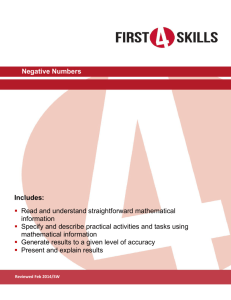LEN - S2
advertisement
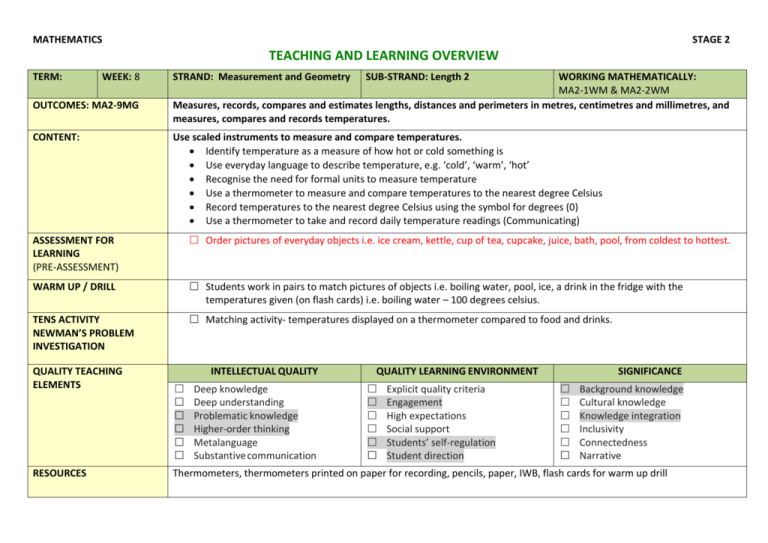
MATHEMATICS STAGE 2 TEACHING AND LEARNING OVERVIEW TERM: WEEK: 8 OUTCOMES: MA2-9MG CONTENT: STRAND: Measurement and Geometry SUB-STRAND: Length 2 WORKING MATHEMATICALLY: MA2-1WM & MA2-2WM Measures, records, compares and estimates lengths, distances and perimeters in metres, centimetres and millimetres, and measures, compares and records temperatures. Use scaled instruments to measure and compare temperatures. Identify temperature as a measure of how hot or cold something is Use everyday language to describe temperature, e.g. ‘cold’, ‘warm’, ‘hot’ Recognise the need for formal units to measure temperature Use a thermometer to measure and compare temperatures to the nearest degree Celsius Record temperatures to the nearest degree Celsius using the symbol for degrees (0) Use a thermometer to take and record daily temperature readings (Communicating) ASSESSMENT FOR LEARNING (PRE-ASSESSMENT) Order pictures of everyday objects i.e. ice cream, kettle, cup of tea, cupcake, juice, bath, pool, from coldest to hottest. WARM UP / DRILL Students work in pairs to match pictures of objects i.e. boiling water, pool, ice, a drink in the fridge with the temperatures given (on flash cards) i.e. boiling water – 100 degrees celsius. TENS ACTIVITY NEWMAN’S PROBLEM INVESTIGATION Matching activity- temperatures displayed on a thermometer compared to food and drinks. QUALITY TEACHING ELEMENTS RESOURCES INTELLECTUAL QUALITY Deep knowledge Deep understanding Problematic knowledge Higher-order thinking Metalanguage Substantive communication QUALITY LEARNING ENVIRONMENT Explicit quality criteria Engagement High expectations Social support Students’ self-regulation Student direction SIGNIFICANCE Background knowledge Cultural knowledge Knowledge integration Inclusivity Connectedness Narrative Thermometers, thermometers printed on paper for recording, pencils, paper, IWB, flash cards for warm up drill TEACHING AND LEARNING EXPERIENCES WHOLE CLASS INSTRUCTION MODELLED ACTIVITIES Define and emphasise appropriate terminology for the sub-strand e.g. temperature, degrees, Celsius, thermometer, hot, cold, hottest, coldest, warm. Demonstrate how to use and read a thermometer. GUIDED & INDEPENDENT ACTIVITIES LEARNING SEQUENCE Remediation S1 or Early S2 LEARNING SEQUENCE S2 Demonstrate how to record on a thermometer (on paper). IWB Game – ordering pictures of objects from coldest to hottest. IWB Game – ordering temperatures for different objects/ days from hottest to coldest. LEARNING SEQUENCE Use the numbers 1-8 to create a scale on the thermometer. Use the following words to describe the scale: freezing, boiling, very cold, very hot, cold, hot, cool and warm. Measure the temperature throughout the day at specific intervals and record on thermometers (on paper). Investigation: Students measure temperature each day at the same time for one month and then make comparisons i.e. the hottest temperature, coldest temperature, difference between the two to nearest degree. Assessment: Compare temperatures inside and outside. Students use a thermometer and measure temperature inside classroom and outside in the sun; record them on a paper thermometer. Write an explanation for the difference? Measure and compare the temperature of places/ countries incorporating below zero temperatures. Extension Late S2 or Early S3 EVALUATION & REFLECTION Use the words very hot, hot, warm, cool, cold and very cold to describe temperatures shown on thermometers. Student Engagement: Resources: Achievement of Outcomes: Follow Up: All assessment tasks should be written in red and planning should be based around developing the skills to complete that task. Assessment rubrics or marking scale should be considered.

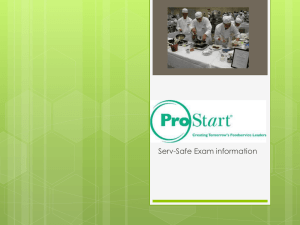
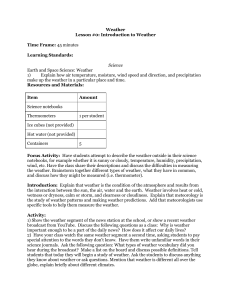
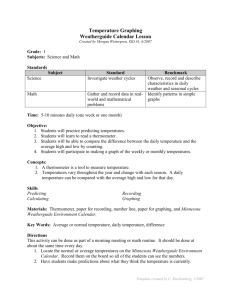
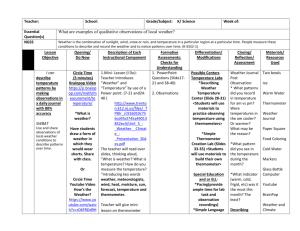


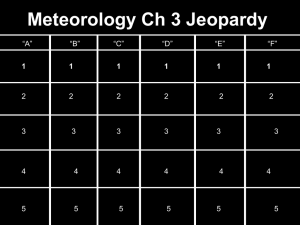
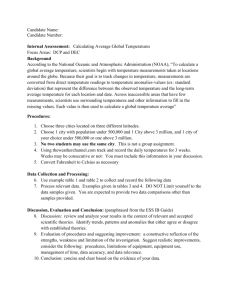

![Temperature Notes [9/22/2015]](http://s3.studylib.net/store/data/006907012_1-3fc2d93efdacd086a05519765259a482-300x300.png)
